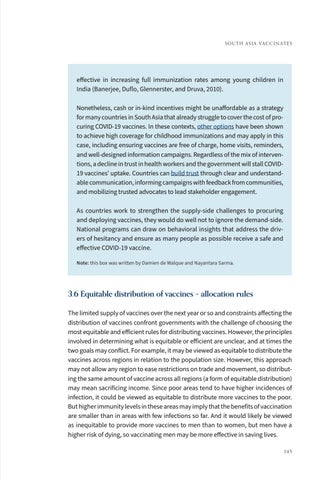S o u t h A s i a Va c c i n a t e s
effective in increasing full immunization rates among young children in India (Banerjee, Duflo, Glennerster, and Druva, 2010). Nonetheless, cash or in-kind incentives might be unaffordable as a strategy for many countries in South Asia that already struggle to cover the cost of procuring COVID-19 vaccines. In these contexts, other options have been shown to achieve high coverage for childhood immunizations and may apply in this case, including ensuring vaccines are free of charge, home visits, reminders, and well-designed information campaigns. Regardless of the mix of interventions, a decline in trust in health workers and the government will stall COVID19 vaccines’ uptake. Countries can build trust through clear and understandable communication, informing campaigns with feedback from communities, and mobilizing trusted advocates to lead stakeholder engagement. As countries work to strengthen the supply-side challenges to procuring and deploying vaccines, they would do well not to ignore the demand-side. National programs can draw on behavioral insights that address the drivers of hesitancy and ensure as many people as possible receive a safe and effective COVID-19 vaccine. Note: this box was written by Damien de Walque and Nayantara Sarma.
3.6 Equitable distribution of vaccines – allocation rules The limited supply of vaccines over the next year or so and constraints affecting the distribution of vaccines confront governments with the challenge of choosing the most equitable and efficient rules for distributing vaccines. However, the principles involved in determining what is equitable or efficient are unclear, and at times the two goals may conflict. For example, it may be viewed as equitable to distribute the vaccines across regions in relation to the population size. However, this approach may not allow any region to ease restrictions on trade and movement, so distributing the same amount of vaccine across all regions (a form of equitable distribution) may mean sacrificing income. Since poor areas tend to have higher incidences of infection, it could be viewed as equitable to distribute more vaccines to the poor. But higher immunity levels in these areas may imply that the benefits of vaccination are smaller than in areas with few infections so far. And it would likely be viewed as inequitable to provide more vaccines to men than to women, but men have a higher risk of dying, so vaccinating men may be more effective in saving lives. 145




